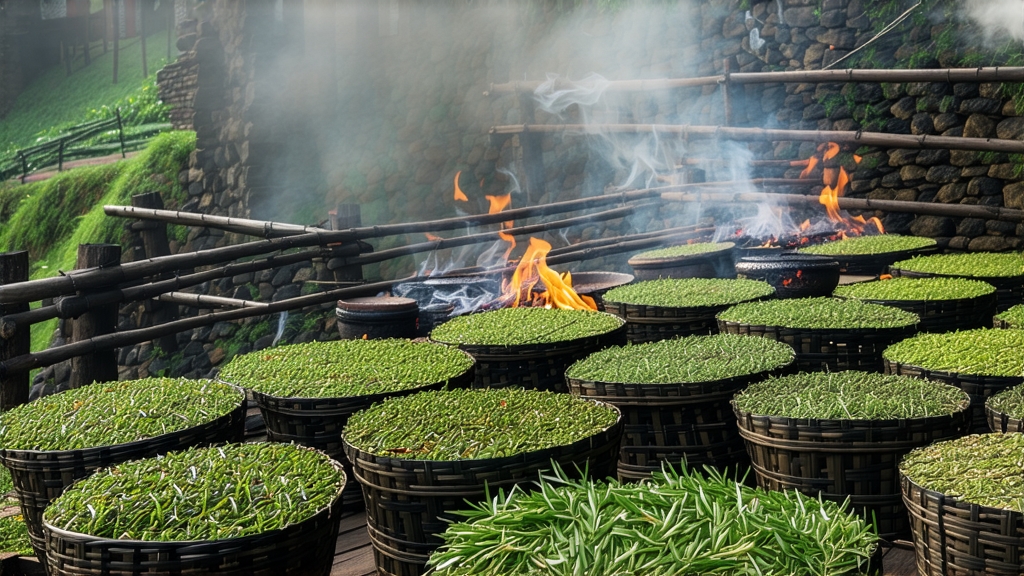
When European tea drinkers first encountered the dark, twisted leaves that produced a liquor as crimson as claret and a scent reminiscent of a Highland campfire, they did not know they were tasting the very first black tea ever created. That tea—Lapsang Souchong—was born in the Wuyi Mountains of northern Fujian around the mid-seventeenth century, centuries before Assam or Ceylon cultivars were even planted. Its name is an anglicized echo of the local phrase “Zheng Shan Xiao Zhong,” literally “small leaf from the original mountain,” a reminder that authenticity can only be claimed by leaves plicked within the 600-square-kilometer core reserve known as Tongmu Guan.
History: From Ming-Era Accident to London Drawing Rooms
Legend credits the birth of Lapsang Souchong to a Qing military unit that commandeered a tea factory during harvest season. To dry the leaves quickly for the impatient troops, workers spread them over fresh pine fires; the smoke penetrated the cell walls and fixed a sweet, resinous character that traveled surprisingly well along the tea-horse road to the port of Xiamen. Dutch merchants carried it to Batavia, then to Amsterdam, and by 1667 the East India Company listed “Bohea Souchong” at 28 shillings a pound—more than twice the price of green tea. Samuel Pepys wrote in his diary that he “did send for a cup of souchong, being told it is the newest drink among the quality.” The tea became the template for every subsequent black tea: withering, rolling, oxidizing, and drying. In short, the world’s entire black-tea family tree begins with these pine-scented leaves.
Micro-Terroir: Why Only Tongmu Guan Can Birth the Original
The Wuyi range is a UNESCO biosphere reserve where subtropical evergreens release terpenes that mingle with cool mountain mist. Day-night temperature swings of 15 °C slow leaf growth, concentrating amino acids. The soil is a crumbly, mineral-rich tuff formed by ancient volcanic ash; X-ray fluorescence tests show twice the magnesium and zinc found in nearby lowland gardens. Within Tongmu Guan, three micro-valleys—Mashu, Guadun, and Miaowan—produce the most sought-after leaves. Farmers insist that the indigenous Xingcun Xiaozhong cultivar, a shrub whose leaves are barely 3 cm long, has adapted over 400 years to absorb and later release pine smoke without turning acrid. Attempts to replicate the process in India, Sri Lanka, or even other Fujian counties yield a blunt, tarry liquor; the mountain’s microbes appear to be silent co-fermenters.
Harvest Calendar and Leaf Grades
Plucking begins on Qingming Day (early April) when buds have opened into the standard “one bud, two leaves” posture. The earliest pick, called Jinzhen (Golden Needle), is reserved for Beijing court-style tribute cakes; only 80 kg are made each year. A week later comes the bulk spring harvest, followed by a lighter autumn picking whose leaves are thinner and require gentler smoke. After sorting, leaves are graded by size and tip content:
- Pekoe Tip (PT): 50 % golden buds, smoked for only 30 minutes; cup is honeyed and lightly piney.
- Superior Souchong (SS): 20 % tips, classic balanced profile.
- Common Souchong (CS): larger leaves, longer smoke, malt-forward; the grade most often found in export tins.
- Smoked Broken (SB): fannings used for Russian caravan blends; intense, almost lapsang-whisky notes.
Craft: The Eight-Stage Pine-Smoke Ballet
- Withering: Leaves are spread on bamboo racks inside Qing-era wooden sheds called qinglou. Pine logs smolder in shallow pits below, raising the temperature to 30 °C while resinous smoke drifts upward. Over 8–10 hours moisture drops from 75 % to 58 %; the leaf becomes velvety and emits a baked-apple aroma.
- Rolling: A 55-cm diameter bamboo drum, turned by foot, bruises cells without breaking them. Oxidative enzymes begin mingling with catechins.
- Oxidation: Leaves rest in rattan baskets for 4–5 hours at 24 °C and 85 % humidity. Color shifts from jade to copper; a sweet raisin